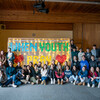Looking around at our small town Sabbath School in Ronan, Mont., I’ve often wondered, Where else do we have discussions about important spiritual topics like faith and salvation but in Sabbath School? The most important business meetings in the world never deal with the critical issues we pick up every Sabbath morning!
Sabbath School has been around for a long time, but it has always been about studying and discussing the most important issues that we ever face—what God has to say about how to live our lives.
James White published the first Sabbath School lessons in the Youth’s Instructor in 1852. Sometimes he would write out the lessons while he and his wife were traveling about encouraging the small groups of believers scattered across the northeastern states. Ellen White described how they would stop at some grassy, shady spot for lunch, and as the horse grazed and she rested with their small son, her husband would use the top of the lunch box or his tall, stovepipe hat for a writing desk. Then he would put his papers in the lining of his hat and put the hat back on his head for safe-keeping as they traveled on.
In 1853, only a few years after the first group of Sabbathkeeping Adventists was formed in Washington, N.H., James White organized the first regular Sabbath School in Rochester, N.Y. From this beginning, Sabbath School membership has exploded from a handful of believers in upstate New York to an estimated 14 million today.
Early Sabbath Schools were not as organized as we’ve come to know them. Study groups would choose their own topics. Often these topics included the books of Daniel, Revelation or others of the Bible. Sabbath School members would study six or seven verses and discuss them. They would search other areas of the Bible for verses that related to the areas they were studying and bring these to the rest of the class for consideration. Many of the early lessons included questions and answer blanks. Students were urged to read the lessons several times and memorize the answers to the questions.
Betty Toews of Ronan remembers when the lesson quarterly format changed to a more open format in the 1970s. “Instead of filling in the blanks, we were asked to think the questions through and come to our own conclusions,” she says. “Some older members would ask, ‘How do we know the right answers?’ They were used to being told what to write in the blanks.” This urging to think for ourselves has had wonderful consequences for many, however.
“I left the church for 20 years,” notes Trica Aloise of Polson, Mont. “When I came back, I found that instead of just talking about whether we should wear lipstick, our Sabbath School discussions now are much more open and relevant. Now we talk about how to have a real relationship with God. This is really where the rubber meets the road.”
Another important element of Sabbath School has always been fellowship. Dian Jenkins of Ronan describes returning to the Missoula church as a young mother and finding the same Sabbath School teacher she had as a young girl still teaching in the children’s divisions. “It gave me such a sense of security to find her still there. Folks thought she would want to be relieved of some of her responsibilities as she got older, but she had never had children, and she told them, ‘How could I leave? These are my children.’ I began teaching in the children’s divisions along with her,” Jenkins adds. “She and her husband were wonderful influences in my life. ”
There’ve been some changes in Sabbath School goals over the years. Some of those in charge of early Sabbath Schools, for example, were unsure it was appropriate to collect offerings during the meetings. In 1878 the secretary at the first annual session of the General Sabbath School Association reported that, though there was a difference of opinion in regard to receiving penny contributions on the Sabbath, “Sister White thought it would be proper.”
Eventually missions became a focus for offerings. In 1885, the Upper Columbia Conference held a session at Milton, Ore., and voted to give all the Sabbath School donations to missions. It was the first conference to go on record as passing such a vote.
“I remember when kids collected buffalo nickels to put in special cards that had slots to hold them,” Jenkins recalls. “Then we got cards that held quarters. I loved to fill up those cards because it helped me feel that even though I was a child, I had a part in the work in raising money for missions.”
Karen Wesslen, a member of the Orchards Church in Vancouver, Wash., describes some of the more recent developments in missions in the North Pacific Union Conference. “Ten to 12 years ago, when Russia opened up to proselytism, Operation Bear Hug organized to send teams into Russia. We’ve also sent out Global Mission Pioneers, who have donated a year of their lives to give Bible studies in India and Africa. Children in our Sabbath Schools have raised money for Bikes for Africa.”
Bible study lessons, fellowship, community work and missions have rich traditions in our Sabbath Schools around the North Pacific Union Conference and around the world, but we have an even richer future. Our most fervent hope is to have our next Sabbath School at Jesus’ knee!







